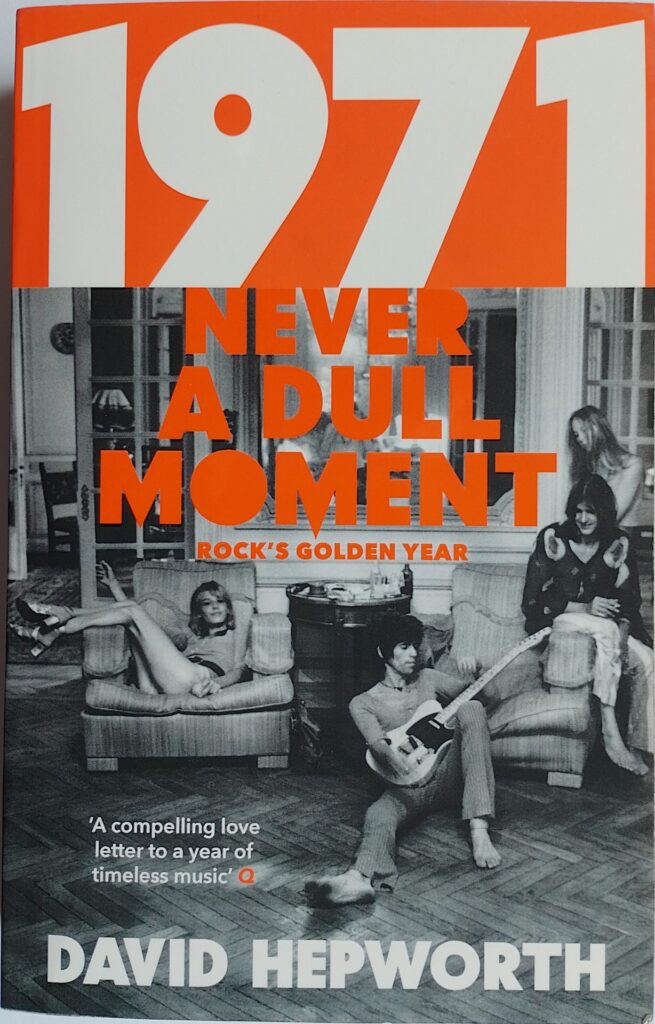First published 2016. Penguin, paperback, 2017, pp 424, c.120,000 words.
This is a comprehensive review of the rock music scene in 1971. It includes an incredible mass of trivia, bizarre facts and amusing anecdotes. Who but an obsessive would have read the sleeve notes to Neil Young’s Harvest and observed that Linda Ronstadt and James Taylor provided backing vocals on a couple of tracks? [p307] Almost everyone born in the 1950s in the West will have heard many of the songs noted here and will have a whale of a time agreeing or disagreeing with Hepworth’s views. However, it adds up to more than just a collection of anecdotes and music lists: by the end we have a pretty good idea how the industry works and why some acts make it and others don’t.
Hepworth tells us that he was born in 1950 and therefore ‘in terms of music I have the winning lottery ticket of life.’ [end page]; i.e. he was around twenty years old in 1971, just the right age for maximum appreciation of the popular music of that year. Given this highly biased perspective, he presents a very good case that 1971 was rock music’s golden year, marking the transition from the single to the L.P., and from pop to rock. The Beatles were at the end of their road together in 1970, leaving the field wide open to a host of new talent. The baby boomers were coming of age and had a bit of money in their pockets to buy records and attend concerts. The industry responded by throwing money at anything that looked like talent.
While one might argue that rock’s golden year was anywhere between 1967 and 1975, there is a good case to be made for 1971. The list of LPs that were issued in that year and still resonate today is certainly impressive: Imagine, Sticky Fingers, and Tapestry for example. Hepworth lists his top 100 1971 releases at the back, and the depth of the list is impressive. Included are albums by The Doors, Led Zepplin, Janis Joplin, Jimmy Hendrix, Nilsson, Velvet Underground, David Bowie (x2), Stevie Wonder, Yes (x2), Paul McCartney, George Harrison, Rod Stewart, Pink Floyd, Deep Purple, … the list goes on and on with legendary names who can still sell out large venues (if they aren’t dead, in which case tribute bands perform their songs instead.)
The book is structured on a month-by-month basis and gives background details of many of the songs released. Each chapter ends with a ‘Playlist’ of ten songs. So January’s list, for example, starts with George Harrison’s My Sweet Lord, but then comes Slade’s Get Down and Get With It. Hepworth is certainly not just including rock-snob tracks, although there are some: Nick Drake’s Bryter Layter is included which no one bought at the time of its release but is now on every cognoscenti’s vinyl display. Anything that has musical merit, or in some way opened a new avenue in rock history, might be included; for example Carpenters by The Carpenters, which any snob wouldn’t be seen dead with, but we all listen to and love – or at least their greatest hits. This part is real High Fidelity nerd territory.
Hepworth writes very fluently and welds together his capacious rag-bag of material with gusto and style, bowling us along for the next quick fix of fact and opinion. He turns a pithy phrase from time to time such as one on Jagger: Having listed some of Jagger’s current and former girlfriends and about to wed Bianca in a crazy over-the-top event – related with relish – Hepworth continues: ‘Having already seen more sex than a policeman’s torch during his years as a pop idol, he understood that fame finds money and becomes glamour.’ [p145] Or this: ‘…activist Abbie Hoffman interrupted The Who’s set to make a statement about the imprisonment of John Sinclair, an interruption which ended when Pete Townshend attacked him with his guitar and told him to “fuck off my fucking stage”. The key word in that sentence was the possessive pronoun. What rock stars really resented, and resented far more than people realised, was the assumption that they could be used, their platform appropriated, their music co-opted to serve the purposes of some of the most self-interested exhibitionists who ever drew breath.’ [p195] Phew. That could only have been written by someone who was closely observant of the industry over a period of time, as Hepworth was from his vantage point as a lifelong rock music journalist.
Hepworth drives to the conclusion that this most ephemeral of arts has proved to have such durability because it framed the lives of those it touched, burrowing its way in during our formative years. Now that we are older, we want to recapture a little of our lost youth by rehearing those classics and communing with our fellows as we observe our icons replaying our lives. Hepworth credits Elvis in 1971 for tapping into the market for nostalgia that today allows the diminishing Stones still to sell out stadiums, not with innovative new material but with the masterpieces they created in that golden time.
If you’re of a certain age this is a hugely enjoyable read about a hugely superficial art that was created by some seriously talented people. As I read it, I felt I was stuffing myself with a box of rich and surprisingly varied but deeply delicious sweeties.
Wikipedia biography of Hepworth: https://en.wikipedia.org/wiki/David_Hepworth
Others’ reviews of the book: https://www.goodreads.com/book/show/26792278-1971—never-a-dull-moment?ref=nav_sb_ss_1_11
© William John Graham, August 2022

